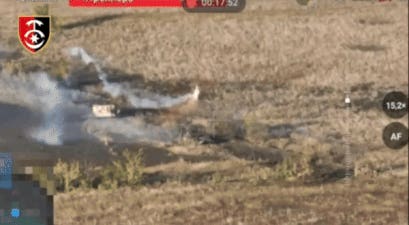In early September, Ukrainian forces deployed hovering drones equipped with tanks full of thermite, a metal incendiary that can burn as hot as 5,000 degrees Fahrenheit. Russian forces soon followed suit, creating their own versions of the Ukrainian “dragon drone”. These drones have primarily targeted bunkers, trenches, and their occupants, as the incendiaries are effective against structures and troops.
Recently, the Ukrainian army’s 30th Mechanized Brigade encountered a Russian tank near Minkivka, resulting in the first documented case of a dragon drone striking a Russian armored vehicle. The tank was immobilized with an anti-tank missile, allowing the Ukrainian drone to spray thermite all over it, turning it into a pyre. This event highlighted the effectiveness of incendiaries as anti-tank weapons.
The U.S. Army conducted a study in 2000 that demonstrated the potential damage caused when napalm or similar combustible materials are sprayed onto tanks. This can lead to the ignition of various components of the tank, as well as ammunition if present, posing a serious threat to mounted soldiers. Despite the effectiveness of incendiaries against armored vehicles, drone operators must ensure accurate targeting to maximize their impact.
While the accuracy of incendiary spray from dragon drones may be limited, drone operators on both sides of the conflict are rapidly gaining skills and knowledge. Ukrainian operators have already demonstrated their ability to target Russian drones mid-air or maneuver explosive drones underneath the armored shells on Russian tanks. With continued practice, drone operators are expected to become more proficient in targeting enemy tanks while they are on the move.
The use of dragon drones and other incendiary-equipped unmanned aerial vehicles represents a new chapter in the Russia-Ukraine conflict. As technology advances and tactics evolve, both sides will likely continue to explore and exploit the capabilities of drones in warfare. With the potential for further developments in drone technology and tactics, the battlefield dynamics in the region may undergo significant changes in the near future.
As drone operators in the conflict gain experience and refine their techniques, the use of incendiary drones against tanks and other targets may become more prevalent. The ongoing evolution of drone warfare in the Russia-Ukraine conflict highlights the importance of adapting military strategies to counter emerging threats and capitalize on technological advancements. As the conflict continues to unfold, the role of drones and other advanced technologies in modern warfare will likely play a crucial role in shaping the outcome of the hostilities.













